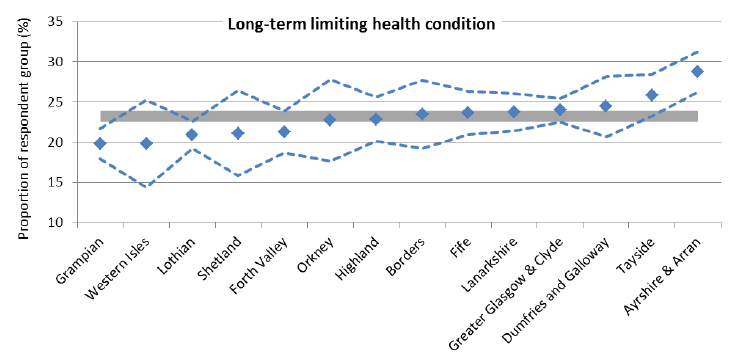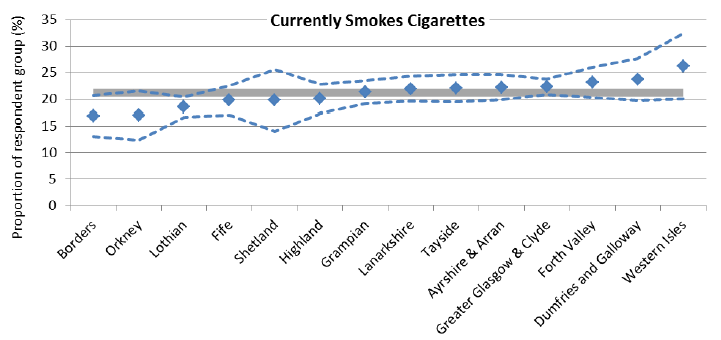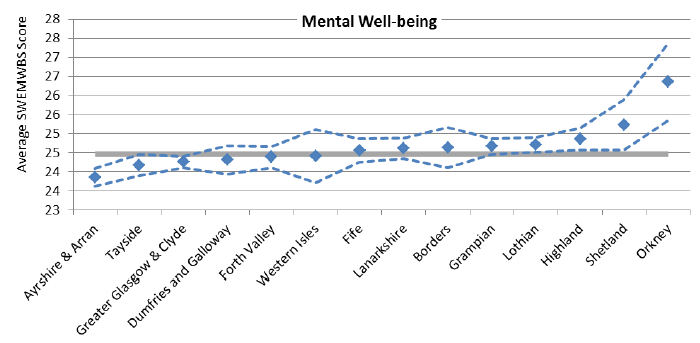Scottish Surveys Core Questions 2014
Official statistics publication on equality groups across a range of measures from harmonised questions across the major SG population surveys.
This document is part of a collection
9 Subnational Geographies
A key strength of the SSCQ is the ability to provide statistics at geographical levels smaller than Scotland as a whole. Results by local authority are available in the supplementary tables published alongside this report [49] . In this section we examine the relevant subnational geographies relating to the indicators, i.e. Health Boards and Police Scotland Divisions.
Where statistical testing is used to identify differences, contrasts are constructed to compare each area to the national average excluding that area, for example to check if Fife is significantly different to the rest of Scotland taken together.
Where p-values are provided, a value of less than 0.05 indicates statistical significance at the 95% level. For more information about statistical tests, see section 11.11.
9.1 General Health
"Good" or "Very good" general health varies between 69% and 80% across health boards. Lower levels can be found in Ayrshire & Arran and Dumfries & Galloway health boards. Higher levels are found in Orkney, Shetland, Lothian and Grampian.
Figure 23: General health by Health Board area, 2014

Across the time series, Lothian has remained above the national average on this indicator for the past three years (2012-14), and Grampian for the past two years (2013-14). Ayrshire & Arran is below national average in 2014, as it was in 2012. No other health boards differ significantly from the national average.
Table 78: General health by Health Board area; changes from 2013 and 2012
| Health Board | 2014 | Change from 2013 |
Change from 2012 |
|
|---|---|---|---|---|
| Ayrshire & Arran |
69.4 |
± 2.6 |
-2.2 |
-0.1 |
| Borders |
72.9 |
± 4.7 |
-4.6 |
-3.1 |
| Dumfries and Galloway |
69.4 |
± 4.3 |
-5.3 |
-1.8 |
| Fife |
75.6 |
± 2.8 |
+1.5 |
+2.9 |
| Forth Valley |
75.3 |
± 2.8 |
-3.2 |
+2.0 |
| Grampian |
77.2 |
± 2.1 |
-1.4 |
+2.1 |
| Greater Glasgow & Clyde |
72.1 |
± 1.5 |
-0.3 |
+0.5 |
| Highland |
74.6 |
± 2.7 |
-3.5 |
-2.0 |
| Lanarkshire |
72.2 |
± 2.5 |
+2.1 |
+0.7 |
| Lothian |
78.6 |
± 1.8 |
-0.5 |
+2.0 |
| Orkney |
79.7 |
± 5.1 |
+2.0 |
-3.6 |
| Shetland |
79.2 |
± 5.4 |
+5.9 |
+3.1 |
| Tayside |
72.3 |
± 2.8 |
-4.1 |
-5.2 |
| Western Isles |
76.2 |
± 4.9 |
+0.3 |
-0.5 |
| SCOTLAND |
74.1 |
± 0.7 |
-1.0 |
+0.4 |
9.2 Long-term Limiting Health Conditions
Figure 24: Long-term limiting health conditions by Health Board Area, 2014

Ayrshire & Arran has the highest prevalence of limiting long-term health conditions at 28.7%, and has shown above average levels on this indicator throughout the timeseries from 2012. The level in Tayside is also higher than the national average (p=0.037) at 25.8%.
Grampian and Lothian have had consistently lower levels throughout the time series (2012-14). The rate in Lothian was 20.9% and in Grampain was 19.8% in 2014, both lower than the national average (p=0.017 and p<0.01 respectively).
Table 79: Long-term limiting health conditions by Health Board area; changes from 2013 and 2012
| Health Board | 2014 | Change from 2013 |
Change from 2012 |
|
|---|---|---|---|---|
| Ayrshire & Arran |
28.7 |
± 2.5 |
+1.6 |
+0.5 |
| Borders |
23.5 |
± 4.3 |
-1.0 |
+0.3 |
| Dumfries and Galloway |
24.4 |
± 3.7 |
+1.3 |
-2.0 |
| Fife |
23.7 |
± 2.7 |
-2.0 |
-0.9 |
| Forth Valley |
21.3 |
± 2.6 |
+2.5 |
-0.0 |
| Grampian |
19.8 |
± 1.9 |
+1.2 |
-1.1 |
| Greater Glasgow & Clyde |
24.0 |
± 1.5 |
-0.0 |
-1.2 |
| Highland |
22.9 |
± 2.7 |
+3.2 |
-0.9 |
| Lanarkshire |
23.7 |
± 2.3 |
-0.7 |
-3.6 |
| Lothian |
20.9 |
± 1.7 |
+2.1 |
+0.1 |
| Orkney |
22.7 |
± 5.0 |
+6.8 |
+3.9 |
| Shetland |
21.1 |
± 5.3 |
-2.6 |
+0.0 |
| Tayside |
25.8 |
± 2.6 |
+3.5 |
+1.8 |
| Western Isles |
19.8 |
± 5.4 |
+0.4 |
+0.8 |
| SCOTLAND |
23.2 |
± 0.7 |
+1.0 |
-0.8 |
9.3 Smoking
Figure 25: Smoking prevalence by Health Board, SSCQ 2014

Estimates of smoking rates across health boards do not deviate greatly from the national average. The only detectable differences are for Greater Glasgow and Clyde ( GGC), higher than the national average at 22.3% (p=0.036), and for Lothian health board, which is below the national average at 18.5% (p=0.042).
Table 80: Smoking prevalence by Health Board area, SSCQ 2014; changes from 2013 and 2012
| Health Board | 2014 | Change from 2013 |
Change from 2012 |
||
|---|---|---|---|---|---|
| Ayrshire & Arran |
22.2 |
± 2.4 |
-1.9 |
-1.9 |
|
| Borders |
16.9 |
± 3.8 |
-1.9 |
-3.0 |
|
| Dumfries and Galloway |
23.7 |
± 4.0 |
+4.7 |
+0.1 |
|
| Fife |
19.8 |
± 2.8 |
-3.1 |
-4.0 |
|
| Forth Valley |
23.1 |
± 2.9 |
+2.1 |
+1.2 |
|
| Grampian |
21.4 |
± 2.1 |
-1.2 |
-0.9 |
|
| Greater Glasgow & Clyde |
22.3 |
± 1.5 |
-1.9 |
-3.1 |
|
| Highland |
20.1 |
± 2.7 |
+1.1 |
-3.8 |
|
| Lanarkshire |
21.9 |
± 2.4 |
-3.7 |
-2.9 |
|
| Lothian |
18.5 |
± 1.9 |
-1.0 |
-4.0 |
|
| Orkney |
17.0 |
± 4.6 |
-3.0 |
-0.1 |
|
| Shetland |
19.8 |
± 5.8 |
+1.1 |
+0.2 |
|
| Tayside |
22.0 |
± 2.6 |
+0.3 |
-2.4 |
|
| Western Isles |
26.1 |
± 6.2 |
+4.4 |
+4.8 |
|
| SCOTLAND |
21.2 |
± 0.7 |
-1.1 |
-2.6 |
|
In line with the fall in the national rate, GGC and Lothian health boards have detectable reductions in smoking prevalence over three years. In GGC smoking rates have fallen each year, from 25.4% in 2012 to 22.3% in 2014. In Lothian there has been a 4 percentage point drop from 2012, from 22.5% to 18.5% in 2014.
Across other health boards, it is not possible to distinguish changes in point estimate from random effects. However, most show a systematic reduction over time.
9.4 Mental Wellbeing
There are significantly higher levels of mental wellbeing as measured by SWEMWBS in Orkney, Shetland and the Highlands compared with the national average. Lower levels were measured in the Ayshire & Arran health board.
Figure 26: Average SWEMWBS score by Health Board area, 2014

Figure 27: Average SWEMWBS score by Health Board area, 2014
| Health Board |
2014 |
|
|---|---|---|
| Ayrshire & Arran |
23.9 |
± 0.2 |
| Borders |
24.6 |
± 0.5 |
| Dumfries and Galloway |
24.3 |
± 0.4 |
| Fife |
24.6 |
± 0.3 |
| Forth Valley |
24.4 |
± 0.3 |
| Grampian |
24.7 |
± 0.2 |
| Greater Glasgow & Clyde |
24.3 |
± 0.2 |
| Highland |
24.9 |
± 0.3 |
| Lanarkshire |
24.6 |
± 0.3 |
| Lothian |
24.7 |
± 0.2 |
| Orkney |
26.4 |
± 1.0 |
| Shetland |
25.2 |
± 0.7 |
| Tayside |
24.2 |
± 0.3 |
| Western Isles |
24.4 |
± 0.7 |
| SCOTLAND |
24.5 |
± 0.1 |
9.5 Provision of Unpaid Care
There are relatively small difference between Health Boards in the proportion of adults providing unpaid care.
In Fife (p<0.001) and Grampian (p=0.003), rates are lower than the national average: 12.9% and 15.6% provide care respectively.
In the Western Isles 27.4% provide unpaid care, significantly higher than the national average (p=0.003).
Table 81: Provision of unpaid care by Health Board area, 2014
| Health Board |
2014 |
|
|---|---|---|
| Ayrshire & Arran |
21.1 |
± 2.7 |
| Borders |
17.8 |
± 4.0 |
| Dumfries and Galloway |
19.1 |
± 3.6 |
| Fife |
12.9 |
± 2.3 |
| Forth Valley |
20.7 |
± 2.9 |
| Grampian |
15.6 |
± 1.9 |
| Greater Glasgow & Clyde |
17.9 |
± 1.5 |
| Highland |
20.3 |
± 2.9 |
| Lanarkshire |
17.4 |
± 2.5 |
| Lothian |
17.3 |
± 1.9 |
| Orkney |
22.4 |
± 6.7 |
| Shetland |
24.3 |
± 6.9 |
| Tayside |
18.8 |
± 2.7 |
| Western Isles |
27.4 |
± 6.4 |
| SCOTLAND |
17.9 |
± 0.7 |
9.6 Perceptions of Local Crime Rate
Since 2012 the proportion of respondents reporting that crime in their local area has fallen or stayed the same has gone up in four Police Scotland Division areas, as shown in Table 82.
In 2014 the highest levels for this indicator (respondents reporting crime had fallen or stayed the same in the past 2 years) were found in Argyll & West Dunbartonshire (80.0%), Tayside (80.2%) and in Renfrewshire & Inverclyde (82.1%).
Renfrewshire & Inverclyde and Argyll & West Dunbartonshire saw the largest increases over the series, up 7.6 and 6.8 points respectively since 2012.
A statistically significant reduction been observed only in Edinburgh; a reduction of 5.7 points since 2012. Edinburgh also had the lowest proportion of adults reporting crime in their local area to be 'a lot less', 'a little less' or 'about the same' in 2014 at 69.8%.
Table 82: Local crime rate by Police Scotland Division; changes from 2013 and 2012
| Police Scotland Division |
2014 |
Change from 2013 | Change from 2012 | |||
|---|---|---|---|---|---|---|
| Aberdeen City |
74.3 |
± 4.3 |
-3.4 |
-4.8 |
||
| Aberdeenshire & Moray |
78.1 |
± 3.3 |
-3.0 |
+0.3 |
||
| Argyll & West Dunbartonshire |
80.0 |
± 3.5 |
+3.3 |
+6.8 |
|
|
| Ayrshire |
74.8 |
± 3.2 |
-2.9 |
+0.8 |
||
| Dumfries & Galloway |
77.5 |
± 5.2 |
-1.7 |
-1.4 |
||
| Edinburgh |
69.8 |
± 3.2 |
-6.9 |
|
-5.7 |
|
| Fife |
78.4 |
± 3.3 |
-2.0 |
+1.4 |
||
| Forth Valley |
79.9 |
± 2.9 |
-2.0 |
+2.4 |
||
| Greater Glasgow |
77.9 |
± 2.1 |
+2.9 |
+3.1 |
|
|
| Highland & Islands |
79.4 |
± 3.3 |
-0.2 |
-1.8 |
||
| Lanarkshire |
78.2 |
± 2.5 |
+3.8 |
|
+4.8 |
|
| Lothians & Scottish Borders |
75.4 |
± 3.3 |
+0.6 |
+2.6 |
||
| Renfrewshire & Inverclyde |
82.1 |
± 3.2 |
+2.4 |
+7.6 |
|
|
| Tayside |
80.2 |
± 3.0 |
+0.0 |
+2.1 |
||
| SCOTLAND |
77.4 |
± 0.8 |
-0.2 |
+1.6 |
|
|
9.7 Confidence in Policing
Analysis of Confidence in Police is conducted on latent classes across all six questions. These statistics are in development and are therefore provided in a supplementary paper available from the SSCQ website. [50]
Contact
There is a problem
Thanks for your feedback

